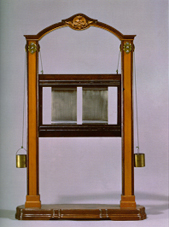
56.8 x 12.5 x 37
Carved and inlaid wood,
iron and bras
INDEX 1788 : T.IV.303
Basis lignea cum duabus parastatis, in quarum crenis positum est parallelogrammum ligneum, duabus laminis ferreis munitum, quod attolli, et deprimi potest ope duorum Cylindrorum plumbo repletorum, qui super trochleas moventur, laminae vero adduci, et abduci possunt a lateribus parallelogrammi; ut radiorum inflexio supra acies lamellarum, et separatio in colores sepectetur. Dissert haec ab illa Machina, quam dedit s´Gravessandius 2728. Tab. LXXXVI. Fig. 2. 3., eosdem tamen effectus producit.
Wooden base with two columns, the grooves of which hold a rectangular wooden frame. The frame carries two iron blades and can be raised or lowered by means of two small pails filled with lead, which move on pulleys. The blades can be moved closer to, or away from, the sides of the frame, permitting observation of the inflection of light rays on the edges of the blades in the frame and splitting into colours. This apparatus differs from 's Gravesande's, 2728. Tab. LXXXVI. Figs. 2. 3., although it produces the same effects.
This instrument, used for optical studies, comprises two metal slides mounted in such a way that they produce a slit, whose width can be adjusted, to collimate beams of light. The blades slide along the grooves in the wooden frame. The frame can be moved vertically between two columns which are fixed on a wooden base. The columns and the suspension system for the frame are identical to those for the prisms described above (instruments 91, 92).
Experiments using this type of slit have helped our understanding of the nature of light. Argument about this question began with Newton and Huygens. Newton believed in a corpuscular model, according to which the propagation of light in space was explained by the existence of small corpuscles emitted by luminous bodies. Huygens, however, developed the wave model which held that light was nothing more than waves that are propagated in space. This dispute was only settled by experiment. One experiment was particularly important; it consisted of directing a beam of monochromatic light on a narrow slit and observing the characteristics of the emerging beam, on a screen. If only one zone were illuminated, along the line of the directed beam, the experiment would support Newton's model. However, a scattering of illuminated fringes, alternating with dark areas, appeared on the screen. This result could only be explained by the wave model, supporting Huygens' theory.
Tab. LXXXVI of 's Gravesande's Physices Elementa shows the conditions of this experiment excellently. The adjustable slit device looks better, from the experimental point of view, than the system in the Gabinete de Física in Coimbra, although the latter is finely decorated.
From Colégio dos Nobres, catalogue n.º 293.'s Gravesande, Willem Jacob, Physices Elementa, Leiden, 1742, Vol. II, §2728, Tab. LXXXVI, Figs. 3, 6, 7.